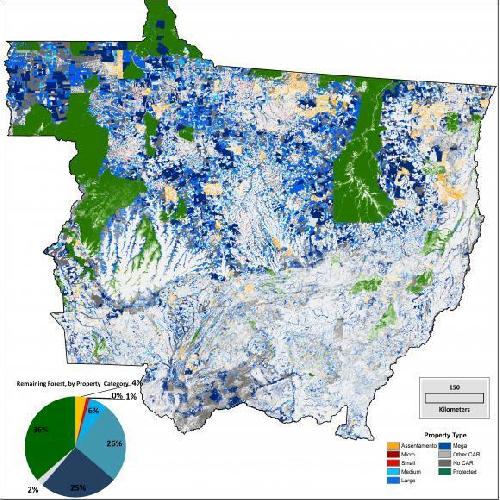PROVIDENCE, R.I. [Brown University] -- Brazil once had the world's highest rate of deforestation. And while land is still being cleared at an alarming rate, the country has been successful in reducing its deforestation in recent decades. Continuing that trend will require continued government enforcement of regulations and the cooperation of landowners who control the fate of much of the the country's remaining forests.
Peter Richards and Leah VanWey, two Brown researchers who have done previous research in Brazil, have published an analysis of property in Mato Grosso, Brazil's third-largest state, to see if they could gain a better understanding of where those efforts should be focused.
Richards and VanWey used data on property size, type, and land use in Mato Grosso's Environmental Registry of Rural Properties, the Global Forest Cover project, and Brazil's National Institute of Space Research's Monitoring Deforestation in the Brazilian Amazon by Satellite Project (PRODES) to complete their analysis. The study reveals the area's distribution of deforestation and how much forest cover remains throughout the land. The information, published in this month's issue of Nature Climate Change, could be useful to policymakers seeking to better understand where to focus anti-deforestation laws.
 This is a graph showing remaining forest cover in Mato Grosso, Brazil, by property type. Credit: Peter Richards/Brown University
This is a graph showing remaining forest cover in Mato Grosso, Brazil, by property type. Credit: Peter Richards/Brown University
Looking at the current distribution of deforestation, remaining forest cover and carbon stocks according to property size, Richards and VanWey, who both have affiliations with Brown University's Institute at Brown for the Environment and Society and its Populations Studies and Training Center, found that nearly two-thirds of remaining forests and carbon reserves are located on private properties, with the majority of those properties owned by large landowners.
Much of the government's current efforts focus on reducing forest loss in areas controlled by small landholders, as it's believed that those landholders clear a higher percentage of their land. Additionally, the analysis looks back at the distribution of deforestation in Mato Grasso when rates were at all all-time high. The data indicated that between 2001 and 2012, when more than 83,000 kilometers of forest were cleared in Mato Grosso, 38 percent of that loss took place on large properties. Because those rates have since declined, it's believed by some involved in the anti-deforestation movement that previous efforts to control deforestation on larger properties have already been successful, which is how the current focus on smaller properties is justified.
"Many researchers have basically declared victory on deforestation among large farmers. Small farmers clear a larger percentage of their land, and large farmers have reduced their rates of clearing in the last decade. But when you look at a whole landscape like Mato Grosso, the large farmers own so much of the land that even lower rates of deforestation translate into big areas and many tons of carbon," said VanWey, associate professor of sociology.
Richards and VanWey predict that Mato Grosso is entering a period of renewed high rates of deforestation because of several factors, including the increasing value of farmland, the growing size of the state's cattle herd, the current dollar-real exchange rate, and the Brazilian government's continued support of export-oriented commodity agriculture.
Brazil's Plan for the Control of Deforestation in the Amazon III focuses on reducing deforestation in smallholder farms, given the success the government previously had in targeting owners of larger properties. But in looking at the results of their analysis, Richards and VanWey advocate for continued focus on larger properties. They argue that high rates of forest loss on small properties will likely have significantly lower impact carbon emissions than forest loss over a broader area.
Richards and VanWey suggest that the government implement both incentives for landowners to maintain their forest cover, like payments for ecosystem services, and bureaucratic and legal obstacles for those looking to clear their lands.
"In the future, Brazil will need to continue to work with its large landowners in the Amazon to preserve the state's remaining forest cover," said Richards, a National Science Foundation postdoctoral fellow. "In some sense, this will likely mean continued restrictions on what can be cleared or how land in the Amazon can be used."
source: Brown University